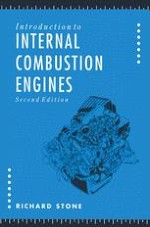1992 | OriginalPaper | Buchkapitel
Compression Ignition Engines
verfasst von : Richard Stone
Erschienen in: Introduction to Internal Combustion Engines
Verlag: Macmillan Education UK
Enthalten in: Professional Book Archive
Aktivieren Sie unsere intelligente Suche, um passende Fachinhalte oder Patente zu finden.
Wählen Sie Textabschnitte aus um mit Künstlicher Intelligenz passenden Patente zu finden. powered by
Markieren Sie Textabschnitte, um KI-gestützt weitere passende Inhalte zu finden. powered by
Satisfactory operation of compression ignition engines depends on proper control of the air motion and fuel injection. The ideal combustion system should have a high output (bmep), high efficiency, rapid combustion, a clean exhaust and be silent. To some extent these are conflicting requirements; for instance, engine output is directly limited by smoke levels. There are two main classes of combustion chamber: those with direct injection (DI) into the main chamber, figure 5.1, and those with indirect injection (ID), figure 5.5, into some form of divided chamber. The fuel injection system cannot be designed in isolation since satisfactory combustion depends on adequate mixing of the fuel and air. Direct injection engines have inherently less air motion than indirect injection engines and, to compensate, high injection pressures (up to 1000 bar) are used with multiple-hole nozzles. Even so, the speed range is more restricted than for indirect injection engines. Injection requirements for indirect injection engines are less demanding; single-hole injectors with pressures of about 300 bar can be used.
